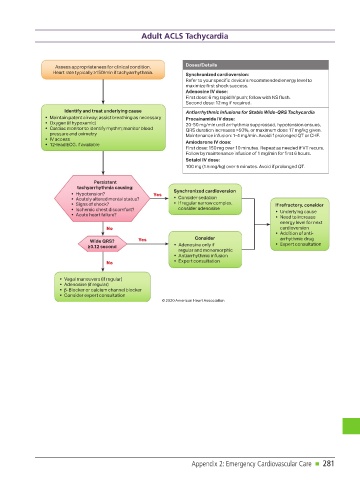Page 283 - PJ MED OPS Handbook 8th Ed
P. 283
Adult ACLS Tachycardia
Adult Tachycardia With a Pulse Algorithm
Doses/Details
Assess appropriateness for clinical condition.
Heart rate typically ≥150/min if tachyarrhythmia.
Synchronized cardioversion:
Refer to your specific device’s recommended energy level to
maximize first shock success.
Adenosine IV dose:
First dose: 6 mg rapid IV push; follow with NS flush.
Second dose: 12 mg if required.
Identify and treat underlying cause Antiarrhythmic Infusions for Stable Wide-QRS Tachycardia
• Maintain patent airway; assist breathing as necessary Procainamide IV dose:
• Oxygen (if hypoxemic)
20-50 mg/min until arrhythmia suppressed, hypotension ensues,
• Cardiac monitor to identify rhythm; monitor blood
QRS duration increases >50%, or maximum dose 17 mg/kg given.
pressure and oximetry
Maintenance infusion: 1-4 mg/min. Avoid if prolonged QT or CHF.
• IV access
Amiodarone IV dose:
• 12-lead ECG, if available
First dose: 150 mg over 10 minutes. Repeat as needed if VT recurs.
Follow by maintenance infusion of 1 mg/min for first 6 hours.
Sotalol IV dose:
100 mg (1.5 mg/kg) over 5 minutes. Avoid if prolonged QT.
Persistent
tachyarrhythmia causing:
Synchronized cardioversion
• Hypotension? Yes
• Acutely altered mental status? • Consider sedation
• Signs of shock? • If regular narrow complex, If refractory, consider
• Ischemic chest discomfort? consider adenosine
• Underlying cause
• Acute heart failure?
• Need to increase
energy level for next
No cardioversion
• Addition of anti-
Wide QRS? Yes Consider arrhythmic drug
• Adenosine only if • Expert consultation
≥0.12 second
regular and monomorphic
• Antiarrhythmic infusion
• Expert consultation
No
• Vagal maneuvers (if regular)
• Adenosine (if regular)
• β-Blocker or calcium channel blocker
• Consider expert consultation
© 2020 American Heart Association
Appendix 2: Emergency Cardiovascular Care n 281

